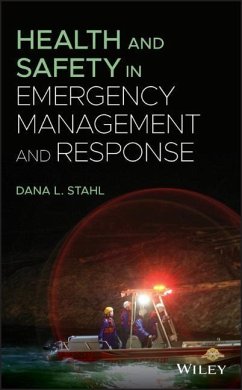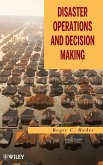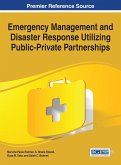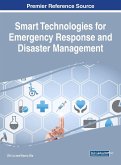Dana L. Stahl
Health and Safety in Emergency Management and Response
Dana L. Stahl
Health and Safety in Emergency Management and Response
- Gebundenes Buch
- Merkliste
- Auf die Merkliste
- Bewerten Bewerten
- Teilen
- Produkt teilen
- Produkterinnerung
- Produkterinnerung
This book familiarizes personnel serving as Emergency Managers, Safety Officers, Assistant Safety Officers, and in other safety-relevant Incident Command System (ICS) roles with physical and psychosocial hazards and stressors that may impact the health and safety of workers and responders in an All-Hazards Response, and ways to minimize exposure. This book provides knowledge on regulations and worker safety practices to the Safety Officer with an emergency responder background, and provides the tools for the Safety Officer with an industrial hygiene or safety professional background that help…mehr
Andere Kunden interessierten sich auch für
![Crisis Decision Making Crisis Decision Making]() Roger C. HuderCrisis Decision Making94,99 €
Roger C. HuderCrisis Decision Making94,99 €![Critical Infrastructure Protection in Homeland Security Critical Infrastructure Protection in Homeland Security]() Ted G. LewisCritical Infrastructure Protection in Homeland Security149,99 €
Ted G. LewisCritical Infrastructure Protection in Homeland Security149,99 €![Risk Centric Threat Modeling Risk Centric Threat Modeling]() Tony UcedaVelezRisk Centric Threat Modeling130,99 €
Tony UcedaVelezRisk Centric Threat Modeling130,99 €![Rewired Rewired]() Rewired84,99 €
Rewired84,99 €![Simulation and Game-Based Learning in Emergency and Disaster Management Simulation and Game-Based Learning in Emergency and Disaster Management]() Simulation and Game-Based Learning in Emergency and Disaster Management229,99 €
Simulation and Game-Based Learning in Emergency and Disaster Management229,99 €![Emergency Management and Disaster Response Utilizing Public-Private Partnerships Emergency Management and Disaster Response Utilizing Public-Private Partnerships]() Emergency Management and Disaster Response Utilizing Public-Private Partnerships219,99 €
Emergency Management and Disaster Response Utilizing Public-Private Partnerships219,99 €![Smart Technologies for Emergency Response and Disaster Management Smart Technologies for Emergency Response and Disaster Management]() Smart Technologies for Emergency Response and Disaster Management246,99 €
Smart Technologies for Emergency Response and Disaster Management246,99 €-
-
-
This book familiarizes personnel serving as Emergency Managers, Safety Officers, Assistant Safety Officers, and in other safety-relevant Incident Command System (ICS) roles with physical and psychosocial hazards and stressors that may impact the health and safety of workers and responders in an All-Hazards Response, and ways to minimize exposure. This book provides knowledge on regulations and worker safety practices to the Safety Officer with an emergency responder background, and provides the tools for the Safety Officer with an industrial hygiene or safety professional background that help them be successful in this role. In order to work together effectively, it is important that anyone responding to an emergency be familiar with all standards and protocols.
Hinweis: Dieser Artikel kann nur an eine deutsche Lieferadresse ausgeliefert werden.
Hinweis: Dieser Artikel kann nur an eine deutsche Lieferadresse ausgeliefert werden.
Produktdetails
- Produktdetails
- Verlag: Wiley / Wiley & Sons
- Artikelnr. des Verlages: 1W119560970
- 1. Auflage
- Seitenzahl: 496
- Erscheinungstermin: 22. Dezember 2020
- Englisch
- Abmessung: 236mm x 161mm x 35mm
- Gewicht: 814g
- ISBN-13: 9781119560975
- ISBN-10: 1119560977
- Artikelnr.: 58778727
- Herstellerkennzeichnung
- Libri GmbH
- Europaallee 1
- 36244 Bad Hersfeld
- 06621 890
- Verlag: Wiley / Wiley & Sons
- Artikelnr. des Verlages: 1W119560970
- 1. Auflage
- Seitenzahl: 496
- Erscheinungstermin: 22. Dezember 2020
- Englisch
- Abmessung: 236mm x 161mm x 35mm
- Gewicht: 814g
- ISBN-13: 9781119560975
- ISBN-10: 1119560977
- Artikelnr.: 58778727
- Herstellerkennzeichnung
- Libri GmbH
- Europaallee 1
- 36244 Bad Hersfeld
- 06621 890
DANA L. STAHL, MS, CIH has more than twenty years of experience managing workplace safety and health programs in manufacturing and with local government. Currently, she is the Safety and Health Manager for The Seattle Public Library, a department of the City of Seattle. She is also an instructor with the Pacific Northwest OSHA Training Center, and has worked at the OSHA Training Center as a content manager with responsibility for updating and maintaining student manuals and curriculum. Previously, she worked as the Manager of Health, Safety and Emergency Management at the Central Puget Sound Regional Transit Authority. She serves on the Public Employee's Panel to the Washington State Governor's Safety Advisory Board, The American Industrial Hygiene Association Incident Preparedness and Response Working Group (IPWRG), and spent five years on the board of the Pacific Northwest Section of the American Industrial Hygiene Association (PNS-AIHA), including as the section's 2016 President.
Foreword xiii
Acronyms xvii
1 Safety in Emergencies and Disasters 1
1.1 Introduction 1
1.2 9/11 Response 2
1.3 Deepwater Horizon 4
1.4 Emergency Responders 9
1.5 Toxicology: How Do We Know What Causes Cancer or Other Health Effects? 14
1.6 Principles of Injury and Illness Prevention 21
1.7 Safety Management in Incident Response 26
1.8 Safety Officer Qualifications 30
1.9 Summary 34
References 35
2 Applicability of Safety Regulations in Emergency Response 39
2.1 The Occupational Safety and Health Act 39
2.2 State Plan States and Territories 41
2.3 Tribes 44
2.4 Safety Requirements in Fire Departments 45
2.5 Safety Requirements in Law Enforcement 47
2.6 Additional Federal Safety Regulations 49
2.7 Safety Expectations in the National Preparedness Goal and Supporting Frameworks 49
2.8 OSHA, ESF #8, and the Worker Safety and Health Support Annex 51
2.9 Safety in State Emergency Management Plans 56
2.10 Liability in Incident Response 60
2.11 Multiemployer Worksites 60
2.12 Summary 62
References 63
3 Types of Emergencies and Disasters, and Related Hazards 65
3.1 The All-Hazards Approach 65
3.2 Hazardous Materials Release or Spill 65
3.3 Severe Weather 75
3.3.1 Extreme Heat 75
3.3.2 Extreme Cold 76
3.3.3 Winter Storms 77
3.3.4 Thunderstorms 78
3.3.5 Hailstorms 78
3.4 Tropical Storms, Hurricanes, and Windstorms 79
3.5 Tornados 83
3.6 Floods 84
3.7 Landslides 88
3.8 Earthquakes 90
3.9 Volcanic Eruption 96
3.10 Tsunami 98
3.11 Fire 99
3.11.1 Chemical Exposures in Firefighting 100
3.11.2 Additional Hazards to Firefighters 107
3.11.3 Wildland Fires 108
3.12 Transportation Incidents 109
3.12.1 Aircraft Incidents 109
3.12.2 Rail Incidents 111
3.13 Pandemic 113
3.14 Radiological Incident 116
3.15 Terrorism Attack: Chemical or Biological Release 118
3.16 Summary 120
References 120
4 Regulatory Requirements and Their Applicability in Emergency Response 127
4.1 Hazard Communication 128
4.2 Personal Protective Equipment 129
4.3 Respiratory Protection 132
4.3.1 Respirator Selection 133
4.3.2 Medical Qualification for Respirator Wearers 136
4.3.3 Respirator Fit Testing 137
4.3.4 Respirator Care and Maintenance 138
4.3.5 Substance Specific Requirements 139
4.4 Blood-borne Pathogens 139
4.5 Fall Protection 143
4.6 Excavations 144
4.7 Confined Space 146
4.8 Hazardous Waste Operations and Emergency Response (HAZWOPER) 147
4.9 Noise exposures 148
4.10 Sanitation and Temporary Labor Camps 151
4.11 Operation of Heavy Equipment 154
4.12 General Duty Clause Citations 155
4.13 Heat 156
4.14 Traffic Control 160
4.15 Ergonomics 160
4.16 Fatigue 162
4.17 Food Safety 165
4.18 Summary 165
References 166
5 Safety Training for a Response 171
5.1 Respirators 172
5.2 PPE 173
5.3 Blood-borne Pathogens 174
5.4 Noise 176
5.5 Chemical Hazards (General) 177
5.6 Chemical-Specific Hazards 178
5.7 Asbestos 179
5.8 Lead 180
5.9 Silica 181
Acronyms xvii
1 Safety in Emergencies and Disasters 1
1.1 Introduction 1
1.2 9/11 Response 2
1.3 Deepwater Horizon 4
1.4 Emergency Responders 9
1.5 Toxicology: How Do We Know What Causes Cancer or Other Health Effects? 14
1.6 Principles of Injury and Illness Prevention 21
1.7 Safety Management in Incident Response 26
1.8 Safety Officer Qualifications 30
1.9 Summary 34
References 35
2 Applicability of Safety Regulations in Emergency Response 39
2.1 The Occupational Safety and Health Act 39
2.2 State Plan States and Territories 41
2.3 Tribes 44
2.4 Safety Requirements in Fire Departments 45
2.5 Safety Requirements in Law Enforcement 47
2.6 Additional Federal Safety Regulations 49
2.7 Safety Expectations in the National Preparedness Goal and Supporting Frameworks 49
2.8 OSHA, ESF #8, and the Worker Safety and Health Support Annex 51
2.9 Safety in State Emergency Management Plans 56
2.10 Liability in Incident Response 60
2.11 Multiemployer Worksites 60
2.12 Summary 62
References 63
3 Types of Emergencies and Disasters, and Related Hazards 65
3.1 The All-Hazards Approach 65
3.2 Hazardous Materials Release or Spill 65
3.3 Severe Weather 75
3.3.1 Extreme Heat 75
3.3.2 Extreme Cold 76
3.3.3 Winter Storms 77
3.3.4 Thunderstorms 78
3.3.5 Hailstorms 78
3.4 Tropical Storms, Hurricanes, and Windstorms 79
3.5 Tornados 83
3.6 Floods 84
3.7 Landslides 88
3.8 Earthquakes 90
3.9 Volcanic Eruption 96
3.10 Tsunami 98
3.11 Fire 99
3.11.1 Chemical Exposures in Firefighting 100
3.11.2 Additional Hazards to Firefighters 107
3.11.3 Wildland Fires 108
3.12 Transportation Incidents 109
3.12.1 Aircraft Incidents 109
3.12.2 Rail Incidents 111
3.13 Pandemic 113
3.14 Radiological Incident 116
3.15 Terrorism Attack: Chemical or Biological Release 118
3.16 Summary 120
References 120
4 Regulatory Requirements and Their Applicability in Emergency Response 127
4.1 Hazard Communication 128
4.2 Personal Protective Equipment 129
4.3 Respiratory Protection 132
4.3.1 Respirator Selection 133
4.3.2 Medical Qualification for Respirator Wearers 136
4.3.3 Respirator Fit Testing 137
4.3.4 Respirator Care and Maintenance 138
4.3.5 Substance Specific Requirements 139
4.4 Blood-borne Pathogens 139
4.5 Fall Protection 143
4.6 Excavations 144
4.7 Confined Space 146
4.8 Hazardous Waste Operations and Emergency Response (HAZWOPER) 147
4.9 Noise exposures 148
4.10 Sanitation and Temporary Labor Camps 151
4.11 Operation of Heavy Equipment 154
4.12 General Duty Clause Citations 155
4.13 Heat 156
4.14 Traffic Control 160
4.15 Ergonomics 160
4.16 Fatigue 162
4.17 Food Safety 165
4.18 Summary 165
References 166
5 Safety Training for a Response 171
5.1 Respirators 172
5.2 PPE 173
5.3 Blood-borne Pathogens 174
5.4 Noise 176
5.5 Chemical Hazards (General) 177
5.6 Chemical-Specific Hazards 178
5.7 Asbestos 179
5.8 Lead 180
5.9 Silica 181
Foreword xiii
Acronyms xvii
1 Safety in Emergencies and Disasters 1
1.1 Introduction 1
1.2 9/11 Response 2
1.3 Deepwater Horizon 4
1.4 Emergency Responders 9
1.5 Toxicology: How Do We Know What Causes Cancer or Other Health Effects? 14
1.6 Principles of Injury and Illness Prevention 21
1.7 Safety Management in Incident Response 26
1.8 Safety Officer Qualifications 30
1.9 Summary 34
References 35
2 Applicability of Safety Regulations in Emergency Response 39
2.1 The Occupational Safety and Health Act 39
2.2 State Plan States and Territories 41
2.3 Tribes 44
2.4 Safety Requirements in Fire Departments 45
2.5 Safety Requirements in Law Enforcement 47
2.6 Additional Federal Safety Regulations 49
2.7 Safety Expectations in the National Preparedness Goal and Supporting Frameworks 49
2.8 OSHA, ESF #8, and the Worker Safety and Health Support Annex 51
2.9 Safety in State Emergency Management Plans 56
2.10 Liability in Incident Response 60
2.11 Multiemployer Worksites 60
2.12 Summary 62
References 63
3 Types of Emergencies and Disasters, and Related Hazards 65
3.1 The All-Hazards Approach 65
3.2 Hazardous Materials Release or Spill 65
3.3 Severe Weather 75
3.3.1 Extreme Heat 75
3.3.2 Extreme Cold 76
3.3.3 Winter Storms 77
3.3.4 Thunderstorms 78
3.3.5 Hailstorms 78
3.4 Tropical Storms, Hurricanes, and Windstorms 79
3.5 Tornados 83
3.6 Floods 84
3.7 Landslides 88
3.8 Earthquakes 90
3.9 Volcanic Eruption 96
3.10 Tsunami 98
3.11 Fire 99
3.11.1 Chemical Exposures in Firefighting 100
3.11.2 Additional Hazards to Firefighters 107
3.11.3 Wildland Fires 108
3.12 Transportation Incidents 109
3.12.1 Aircraft Incidents 109
3.12.2 Rail Incidents 111
3.13 Pandemic 113
3.14 Radiological Incident 116
3.15 Terrorism Attack: Chemical or Biological Release 118
3.16 Summary 120
References 120
4 Regulatory Requirements and Their Applicability in Emergency Response 127
4.1 Hazard Communication 128
4.2 Personal Protective Equipment 129
4.3 Respiratory Protection 132
4.3.1 Respirator Selection 133
4.3.2 Medical Qualification for Respirator Wearers 136
4.3.3 Respirator Fit Testing 137
4.3.4 Respirator Care and Maintenance 138
4.3.5 Substance Specific Requirements 139
4.4 Blood-borne Pathogens 139
4.5 Fall Protection 143
4.6 Excavations 144
4.7 Confined Space 146
4.8 Hazardous Waste Operations and Emergency Response (HAZWOPER) 147
4.9 Noise exposures 148
4.10 Sanitation and Temporary Labor Camps 151
4.11 Operation of Heavy Equipment 154
4.12 General Duty Clause Citations 155
4.13 Heat 156
4.14 Traffic Control 160
4.15 Ergonomics 160
4.16 Fatigue 162
4.17 Food Safety 165
4.18 Summary 165
References 166
5 Safety Training for a Response 171
5.1 Respirators 172
5.2 PPE 173
5.3 Blood-borne Pathogens 174
5.4 Noise 176
5.5 Chemical Hazards (General) 177
5.6 Chemical-Specific Hazards 178
5.7 Asbestos 179
5.8 Lead 180
5.9 Silica 181
Acronyms xvii
1 Safety in Emergencies and Disasters 1
1.1 Introduction 1
1.2 9/11 Response 2
1.3 Deepwater Horizon 4
1.4 Emergency Responders 9
1.5 Toxicology: How Do We Know What Causes Cancer or Other Health Effects? 14
1.6 Principles of Injury and Illness Prevention 21
1.7 Safety Management in Incident Response 26
1.8 Safety Officer Qualifications 30
1.9 Summary 34
References 35
2 Applicability of Safety Regulations in Emergency Response 39
2.1 The Occupational Safety and Health Act 39
2.2 State Plan States and Territories 41
2.3 Tribes 44
2.4 Safety Requirements in Fire Departments 45
2.5 Safety Requirements in Law Enforcement 47
2.6 Additional Federal Safety Regulations 49
2.7 Safety Expectations in the National Preparedness Goal and Supporting Frameworks 49
2.8 OSHA, ESF #8, and the Worker Safety and Health Support Annex 51
2.9 Safety in State Emergency Management Plans 56
2.10 Liability in Incident Response 60
2.11 Multiemployer Worksites 60
2.12 Summary 62
References 63
3 Types of Emergencies and Disasters, and Related Hazards 65
3.1 The All-Hazards Approach 65
3.2 Hazardous Materials Release or Spill 65
3.3 Severe Weather 75
3.3.1 Extreme Heat 75
3.3.2 Extreme Cold 76
3.3.3 Winter Storms 77
3.3.4 Thunderstorms 78
3.3.5 Hailstorms 78
3.4 Tropical Storms, Hurricanes, and Windstorms 79
3.5 Tornados 83
3.6 Floods 84
3.7 Landslides 88
3.8 Earthquakes 90
3.9 Volcanic Eruption 96
3.10 Tsunami 98
3.11 Fire 99
3.11.1 Chemical Exposures in Firefighting 100
3.11.2 Additional Hazards to Firefighters 107
3.11.3 Wildland Fires 108
3.12 Transportation Incidents 109
3.12.1 Aircraft Incidents 109
3.12.2 Rail Incidents 111
3.13 Pandemic 113
3.14 Radiological Incident 116
3.15 Terrorism Attack: Chemical or Biological Release 118
3.16 Summary 120
References 120
4 Regulatory Requirements and Their Applicability in Emergency Response 127
4.1 Hazard Communication 128
4.2 Personal Protective Equipment 129
4.3 Respiratory Protection 132
4.3.1 Respirator Selection 133
4.3.2 Medical Qualification for Respirator Wearers 136
4.3.3 Respirator Fit Testing 137
4.3.4 Respirator Care and Maintenance 138
4.3.5 Substance Specific Requirements 139
4.4 Blood-borne Pathogens 139
4.5 Fall Protection 143
4.6 Excavations 144
4.7 Confined Space 146
4.8 Hazardous Waste Operations and Emergency Response (HAZWOPER) 147
4.9 Noise exposures 148
4.10 Sanitation and Temporary Labor Camps 151
4.11 Operation of Heavy Equipment 154
4.12 General Duty Clause Citations 155
4.13 Heat 156
4.14 Traffic Control 160
4.15 Ergonomics 160
4.16 Fatigue 162
4.17 Food Safety 165
4.18 Summary 165
References 166
5 Safety Training for a Response 171
5.1 Respirators 172
5.2 PPE 173
5.3 Blood-borne Pathogens 174
5.4 Noise 176
5.5 Chemical Hazards (General) 177
5.6 Chemical-Specific Hazards 178
5.7 Asbestos 179
5.8 Lead 180
5.9 Silica 181








